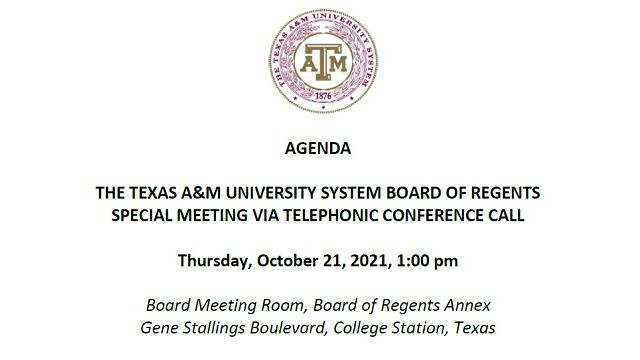
The Texas A&M system board of regents held a special meeting on Thursday, in part to get an update about conflicting pandemic vaccination orders from the president and the governor.
A system spokesman said after the regents discussed the issue in executive session, “Our lawyers are continuing to evaluate the impact and options for the A&M System.”
Following the executive session, the regents unanimously approved three items without discussion. Quoting the agenda:
Item 1 – Authorization to Amend Ground Lease of Approximately 48 Acres of Land Relating to the Park West student housing development in Brazos County, Texas, A&M System
Item 2 – Authorization for the President to Negotiate and Execute a Reimbursement Agreement with The Association of Former Students for Costs Incurred for the Stormwater System Project, Texas A&M
Item 3 – Action to Increase by $10 Million the Authorization Previously Granted to TDEM for Purchase of Warehouse Properties, A&M System
That was followed by system lobbyist Jenny Jones updating the regents on action taken during the legislature’s third special session. That was followed by regents chairman Tim Leach of Midland thanking system employees.
Click below for comments from the legislative update during October 21, 2021 meeting of the Texas A&M system board of regents:
News release from the Texas A&M system recapping legislative action during the third special session:
Generations of Texans are poised to benefit from action by the Texas Legislature Tuesday to fund $3.35 billion in specific capital projects for Texas higher education institutions.
Capital projects at universities of The Texas A&M University System would total $727.4 million under SB 52. That is 22 percent of the total authorization.
Separately, the Legislature appropriated $300 million in federal COVID relief funds to build a new state operations center in Austin for the Texas Department of Emergency Management (TDEM,) one of eight state agencies overseen by The Texas A&M System.
The COVID-related appropriations bill, SB8, also invests $20 million toward supporting at-risk students at the state’s regional universities, including those associated with the A&M System.
Both bills now go to Governor Greg Abbott for approval.
Chancellor John Sharp thanked Lt. Gov. Dan Patrick, Speaker Dade Phelan, Sen. Brandon Creighton, Sen. Jane Nelson and Rep. Greg Bonnen for their leadership and all of the members of the House and Senate who supported the legislation.
“We are gratified by the confidence the Legislature shows in The Texas A&M System to be good stewards of tax dollars,” Sharp said. “We will continue to earn that trust as we serve the students and citizens of this great state.”
The Chancellor also thanked Abbott for including higher education in the third special session this fall. SB 52 is the first legislation since 2015 to tackle a comprehensive list of capital projects for the state’s public colleges and universities.
The Texas A&M System educates more than 150,000 students, about half of them attend one of 10 regional universities throughout Texas — from A&M Texarkana to Texas A&M International in Laredo, and from West Texas A&M in Canyon to A&M Corpus Christi.
Funding for capital projects in SB 52 include:
Prairie View A&M: $45 million
Tarleton State-Stephenville: $65 million
Tarleton State- Ft. Worth: $25 million
A&M Central Texas: $45 million
A&M Corpus Christi: $45 million
A&M Kingsville: $45 million
A&M San Antonio: $45 million
A&M International: $45 million
West Texas A&M: $45 million
A&M Commerce: $45 million
A&M Texarkana: $45 million
A&M HSC-McAllen: $30 million
A&M Galveston: $34 million
Texas A&M College-Station: $56 million
Texas A&M System-RELLIS: $43 million
The legislation also includes $70 million for each of three public institutions who helped start the new biomedical research campus at the Texas Medical Center in Houston: The Texas A&M Health Science Center, the University of Texas Health Science Center and University of Texas MD Anderson Cancer Center.
In College Station, the $56 million would fund a new clinical teaching and research complex for the Texas A&M College of Veterinary Medicine & Biomedical Sciences, where class sizes have grown dramatically to address the need for veterinarians across the state.
The separate proposal for $300 million in COVID relief funding for TDEM would put disaster preparedness, response, recovery, and mitigation under one roof.
The current State Emergency Operations Center (SOC), built in the 1950s, is considered outdated, too small, and without the high-tech capabilities to manage state-level emergency management operations. Texas has more federal disaster declarations than any other state and coordinates 3,000 to 4,000 local incidents each year.
